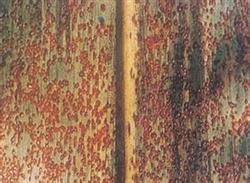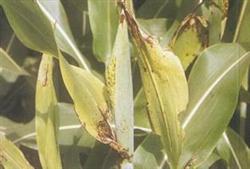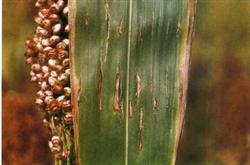Chemical control of sorghum rust

Symptom sorghum rust begins to occur before and after heading. Red or purple to light brown spots were formed on the leaves, and then with the expansion of the pathogen, the spots expanded and formed an oval protuberant heap of summer spores on the leaf surface, which revealed beige powder, namely summer spores. In the later stage, the teliospore pile was formed in the same place, which was darker and larger than the microspore pile. Regular occurrence of pathogens overwintering with winter spores on diseased remains, soil or other hosts. When the conditions were suitable in the following year, the teliospores germinated and basidiospores invaded the young leaves to form the gonadal organ, and then the rust organ was produced on the back of the disease spot. After flying and spreading, the rust spores germinated when there were water droplets on the leaves, and also invaded from the leaves to form summer spores and summer spores, which were transmitted by air flow and re-infected many times. When sorghum is close to harvest, teliospores are formed in the place where summer spores are produced, and winter spores are used to survive the winter. It is easy to get sick in the rainy season from July to August. In the early stage of the disease, 25% triadimefon wettable powder 1500 Mel 2000 times, or 40% carbendazim suspension 600 times, or 80% Shiprolol (Dysen zinc) wettable powder 600 times 800 times, or 25% benzonazole EC 3000 times, once every 10 days, for 3 times in a row.
- Prev

Sorghum leaf spot disease
The symptoms are also known as spot disease. The disease can occur in all parts of the plant, mainly harmful leaves. The plaque is irregular in shape, long to fusiform or semicircular in size, up to more than 1cm, yellowish brown to grayish brown, with reddish purple edges. The disease spot often begins at the edge or end of the leaf, and some occur on the leaf surface or the upper part of the ear.
- Next

Sorghum bacterial red streak
The main symptoms are damage to leaves. At first, the leaf spot showed a small, narrow, watery spot, and after expansion, it became light reddish brown. Some plaques turn brown in the center and red on the edges, and wide long oval spots appear intermittently on the stripes. Sometimes the disease spot can cover most of the leaf area. When the humidity is high, the pus of the small granular bacterial vaccine can be seen to overflow and dry.
Related
- The first cup of black tea in spring, the flavor and history of tea gardens in Kenya, Africa
- The computer can not only choose potatoes, but also grow tea rice. AI will grow winter oolong tea champion.
- It is not only the inflated tea bitten by insects, but also engraved with the four seasons tea in Beipu.
- The Oriental Beauty Tea Festival in Zhuxian County takes the stage at the weekend to experience the plus-size feast of oil tea.
- & quot; Oriental Beauty Tea & Exploration of Emei in Hsinchu, the hometown of quot;
- The new variety of strawberry "Tainong 1" dessert is the first choice with mellow aroma. Crimson gorgeous
- History of Tea in Taiwan: from Wild Inner Mountain to Export Tea Garden
- Two types of Taiwan Oriental Beauty Black Tea won the British three-Star Award for Childhood Tea Xiang Zhang Jiaqi changed from pilot to champion tea maker.
- Banana species and varieties: the planting history of Taiwan Xianren banana and dwarf banana is long, is banana disease resistant?
- Coffee planting Technology: Qianjie Coffee from Seedling to harvesting

